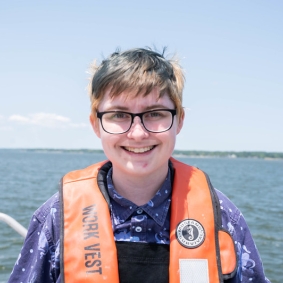Eight students will be presenting the summer work at the Ocean Sciences Meeting in March 2022!
Imogen Southerland, Texas A&M University, College Station
Class Year:
2023Mentor:
Louis Plough, Ph.D.Project Title:
Low Salinity Conditioning Stress to Improve C. virginica Survivability in Natural Stressful EnvironmentsAbstract:
The eastern oyster, Crassostrea virginica, is a prevalent foundation and commercial fishery species along the eastern coast of the United States (Wilberg 2011). Recently, restoration efforts have been made in order to restore oysters in the Chesapeake Bay, successfully increasing oyster populations in the wild and allowing for growth in commercial fisheries instead of overharvesting of wild oysters (Gray 2022). However, with increased rainfall in the spring months causing decreased salinity followed by the increased summer temperatures, oysters populations are showing mass mortality (e.g. McCarty et al 2020). This experiment tests the utility of hormesis or ‘stress priming’— the increase in stress tolerance following initial exposure to a sublethal stress—for C. virginica through a low salinity stress treatment on juvenile spat (approximately 1 year old). In order to determine the success of stress priming, a secondary stress condition was applied to oysters given varying days of primary stress. Oysters were measured for heat shock protein (HSP) expression and basic phenotypic traits (growth and survival). Throughout both the primary and secondary stresses, gill tissue—the main immune organ of oysters—was sampled from oysters for RNA and relative expression of Hsp70 and Hsp90 was measured via qPCR (quantitative Polymerase Chain Reaction). Beta actin was used as a housekeeping gene while the stress family of heat shock proteins, specifically Hsp70 and Hsp90, were quantified and the change between Beta actin and each HSP was calculated via the 2-ΔΔCt method of analysis. Oysters showed very little changes in height and weight, but showed distinct differences in mortality with 2 days primary stress (2dPS) group showing the best stress priming. 8 days primary stress (8dPS) oysters showed anti-stress priming qualities via increased mortality and Hsp70 expression; 14 days primary stress (14dPS) showed some stress priming via reduction of Hsp70 expression but still had elevated mortality.



